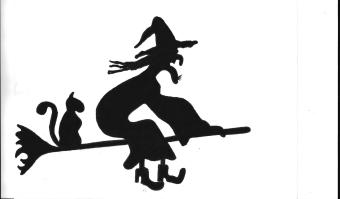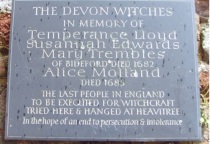
WITCHCRAFT IN THE WEST COUNTRY
Exeter Library on 16 April 2015
A talk by Steve Patterson of the Boscastle Museum of Witchcraft, explained many of the fascinating factors which contributed to what was, in effect, witch discrimination.
In 1682 Temperance Lloyd and two other women were hanged in Exeter as witches. The evidence against them was flimsy and hearsay; birds were supposed to have flown into a window and suckled from Temperance and she believed a dark shadowy male had told her to commit evil acts. She, Mary Trembles and Susannah Edwards were also considered to be the cause of other people’s illnesses – one doctor even suggesting witchcraft when he couldn’t cure a patient – but what is impossible to understand is that all three accused insisted on “confessing” to the crimes they were accused of. It may have been because they believed the “dark shadowy man” would save them.
Devils were believed to be able to assume many forms; they were known as “shape shifters”. Temperance’s shadowy male would have been the devil in one of his many disguises. There was also a sexual element in the attitude to witches - accusations of suckling of private parts by animals (who were considered, of course, to be more shape-shifting devils).
The Saxons had anti-witchcraft laws but James I, paranoid and pedantic, went one further and said that to deny the existence of witches was heresy! In 1604 during his reign the Witchcraft Act was passed. Fifty years later, this law came in most useful. When the Civil War ended in 1657 with the country plunged into chaos, people were desperate to find someone – or something – to blame for their poverty, hunger and instability (which was, as is so often the case, simply the consequence of the war). Witches were the fall guys.
However, English witches were better off than their European counterparts. In Europe in the battle between good and evil, witches were supposed to be in league with the devil so therefore were considered to be heretics, subversive and anti the church. For this the penalty was burning. There were reports of witches indulging in orgiastic devil-worshipping ceremonies and nocturnal gatherings.
But in England (not Scotland which followed Europe’s example) the accusations against witches were legal, not theological. English law allowed for the burning of heretics but witches were not considered to be a religious (or anti-religious) group. They were thought to be possessed by a “familiar spirit”.
This “familiar”, as in the case of poor Temperance Lloyd, was believed to make their hosts commit unacceptable acts. One way to undo the damage was for the sufferer to scratch the witch until she bled, and that would somehow return the familiar to the witch and leave the sufferer alone.
Magic itself was not considered to be either good or bad. It was neutral. But religious leaders insisted these witches were weak and credulous and the poor women themselves were accused of being Catholic or Protestant or Muslim or Jewish – depending on which minority group it was fashionable to blame.
For all the Church’s condemnation of the practice of magic, “ghost slayers” were often members of the clergy. There is a story of a Rev Stephen Hawker who received help from the Bishop of Exeter for his ghost-slaying activities – and this was around the time that Temperance Lloyd was being tried for practicing witchcraft.
Over fifty years later, the 1735
Witchcraft Act emphasised change in that witches were no longer criminal but were by now considered to be fraudulent. They were punished by fines and imprisonment. This law was only repealed in
1951!
Right up to the 20th Century rural districts still had “charmers”. These were “good” witches who healed and who specialised in clearing common diseases, such as ringworm. They made no charge for this
service, believing it to be a gift out of which they should not profit.
In closing, Steve pointed out that many people still have a profound belief in the power of witchcraft which has, after all, been part of our culture for centuries, and that magic is still considered by many to be a potent and real force.
TO RETURN TO THE HOME PAGE CLICK "HOME" AT THE TOP OF THIS PAGE


